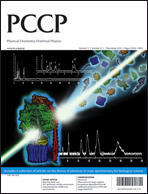A simple physical model for the simultaneous rationalisation of melting points and heat capacities of ionic liquids†
Abstract
The analysis of potential energy surfaces of ion pairs within the framework of an anharmonic oscillator model allows rationalization and prediction of melting points (Tmp) and heat capacities (


 Please wait while we load your content...
Please wait while we load your content...